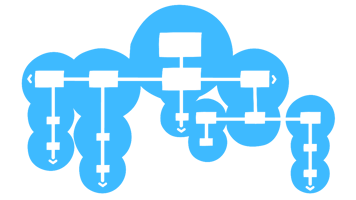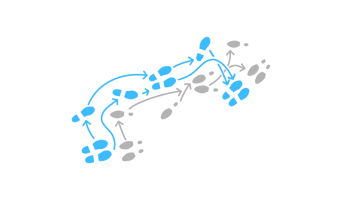Whether you are attracted to Holacracy or not - the model and the examples of its implementation offer crucial insights for organizational innovation. We discuss five learnings that any effort to build more decentralized organizational designs should take into account.
Holacracy* continues to be a provocation for org designers and managers committed to traditional organizational structures. Conversations about the model are thus often tilted to the extremes: many managers either seem to love it or hate it.
Those who love the model are attracted to the radical alternative to traditional corporate structures that Holacracy offers. This is often based on the system’s most striking features. For example, the apparent abolishment of bosses, some hope, will do away with the problems of bad leadership once and for all.
Those who are more skeptical cite failed implementations or much reported issues with existing live cases. Many middle managers steeped in complex traditional management structures refuse point-blank to embrace the idea of Holacracy based on its most superficial features, preemptively declaring “This will never work here”. And even those who are curious are often wary of the massive change effort required to fully migrate an organization to the new system.
At Management Kits, we believe that the Holacracy model represents a notable contribution to the search for novel management structures that rely, in varying degrees, on decentralized authority and enable adaptable management structures and continuous change. In exploring what we can learn from Holacracy for organization design and management practice, we rely on a close study of the model itself, first-hand practical insights from Holacracy implementation work we have been able to observe and analyze, and an emergent stream of academic research.
Hence, the key question is not whether you like Holacracy or hate it, but what can you learn from the model and its evolution for organization design and management – regardless of whether you’re looking to go all-in for a fundamentally new model or simply evolve your given management structure. The goals for many organizational strategists remain the same: to build an organization that’s more nimble in the face of a changing environment, more responsive to your people’s needs, or more effective in achieving its key objectives.
Here are the key points we think Organization Designers can learn from engaging in Holacracy:
It requires a strong and formalized overall framework to replace the single-boss leadership model, a central building block of traditional management
A classic hierarchical model for organizing at scale has two key advantages. First, it’s simple. Second, it’s been around for ages and most managers have learned to live with it (and get work done within it), one way or the other.
For better or worse, replacing this inherited management model – or even elements of it –requires a major reframing of how organizing is supposed to work.
The Holacracy model is sometimes criticized for its strict formality – think of the constitution or the meticulously scripted meetings. However, we think that this formalization is a key advantage when it comes to replacing traditional models: the highly formalized nature of the model creates a strong reference for people changing to a new way of organizing.
We’re not proposing that a constitution, strict role models, or scripted meeting processes etc. are the only way to enable innovative forms of organizing. But organization designers are well advised to reflect on what those elements do and to consider which questions remain unanswered if they are not addressed one way or another.
Drive organizational innovation
with Management Kits
Holacracy is one noteworthy example (and there are other novel models out there) of how to distribute formal leadership within teams, define roles, and build democratic elements into an organization’s governance
Shared and collaborative leadership have long been recognized as important features of high performing teams. At the same time, many novel forms of organizing have at their core a detailed template for how teams should organize and interface with other parts of the organization. Think of the Scrum methodology with its distinction of Scrum Master and Product Owner, or Spotify’s Tribes & Squads model, which distinguishes between Task Product Owner, Chapter Lead, Tribe Lead, and Agile Coach.
While Holacracy is part of this list of shared and collaborative models, it uses a particular distribution of leadership roles within “circles”, the Holacracy terminology for overlapping teams. Every circle has a Lead Link, a Rep Link, a Facilitator, a Secretary, and, in some cases, a Cross Link role.
Besides the renewed relevance of the Organization Development function in those arrangements, organization designers can benefit from studying this set of roles (and their respective accountabilities) when designing shared leadership into team set-ups. For example, the Cross Link role, a kind of lateral liaison role, is a good example of how to bridge silos.
Besides the required leadership roles, we find the general Holacracy template for defining roles, with its three dimensions of Purpose, Accountabilities, and Domains, to be a slick and elegant guide. And the clearly scoped democratic elements of electing some of the leadership roles can remind organization designers that democracy (in organizations and elsewhere) requires a careful balancing of institutional mechanisms. In other words, organizational democracy is not simply black (no participation in decision-making or appointments) or white (every decision is put to a vote).
Creating space not only for “what we work” but also for “how we work”, for “working on the organization” and “in the organization”
Even if they don’t fully buy into the Holacracy model, organization designers can find inspiration in a basic distinction that HolacracyOne founder Brian Robertson draws between “working in the organization” and “working on the organization”. In my view, this distinction highlights how effective collaborative work always entails some element of managing and organizing. And that element of managing and organizing is independent of formal role or managerial position.
Many effective managers I have worked with have understood this distinction very well, even if they don’t use this terminology. “Working on the organization” can mean many things: understanding which stakeholders need to be involved in making an important decision; being aware of and actively shaping timing and language to steer organizational processes; or being actively involved in defining roles and governance processes as a precondition for moving things forward.
Organization designers can shape organizations in view of platforms, processes, or institutional forms that explicitly enable organizational members to “work on the organization” in a productive way (and not only by informal means).
The gaps and failings in Holacracy case studies are instructive as they point to key issues that any alternative model (and any good management system) will have to address
One achievement of HolacracyOne and its founder, Brian Robertson, is the business model innovation behind Holacracy: namely the open source service model behind the “organizational operating system” and the rapid uptake of the model in a large number of first mover organizations around the globe. For organization designers and management researchers, one side effect has been the high number of cases, data, and evidence relating to self-managing organizations.
In addition to the learnings from studying the model, there are many things to be learned from its application. I would argue that there is more to be learned from failures and challenges in implementation cases than from success stories. Failures and challenges might be due to particular contexts, but they can also point to some fundamental issues that must to be addressed in any innovative form of organizing that seeks a radical decentralization of decision-making power.
I have studied a number of cases where Holacracy was explored or even initially implemented and then decommissioned. In these cases, Holacracy did in fact induce change, as the organizations did not simply revert back to their old models, but defined a third way that included elements of self-organizing. I’m sure that would not have been the case if people at those companies had not engaged with Holacracy in the first place.
Holacracy represents an evolution of an earlier, alternative self-management model called Sociocracy
Holacracy is an adaptation of an older model called Sociocracy, developed in the Netherlands in the mid-20th century. Holacracy founder Brian Robertson enthusiastically discussed the implementation of Sociocracy at his company before he came up with his adaptation of that model.
Holacracy can thus be studied by organization designers as a model for management or organizational innovation. It puts a special focus on radical forms of self-managing organizations and their evolution over time. In this evolution story, Holacracy will not be the last word in novel models for organizing, but it is a very significant step.
*Holacracy is a trademark of the company HolacracyOne. You can learn about their services here.



